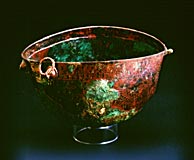The fall of the Empire
Although the last Meroitic monarch known by name was Yesbokheamani
(283 - 300 AD), 30 years later the dead rulers were still buried in
the Northern cemetery of Meroe. On the other hand, an inscription
of an Ethiopian king Aezana, discovered in the city of Axum and dated
to c. 350 AD, reports a war with the Noba people and the conquest of
Al-Butana. Probably at that time the kingdom of Meroe no longer existed.
Whether the hegemony of Meroe collapsed due to an internal crisis,
or whether its fall was partly brought about y raiding nomads from
the desert, is a question that cannot be decisively answered...
The nomads build tumuli...
The next two centuries, the so-called Post-Meroitic period, is one
of the most mysterious and least recognized periods in the history
of the Sudan. Monumental architecture and knowledge of writing disappeared
altogether, and in the belt between Sennar and the Fourth Cataract
there appear earth burial tumuli of the Tanqasi culture, today the
only legible remains of the Noba nomad tribes who arrived at this region
from the territories of modern Kordofan. An especially large and richly
equipped burial ground was discovered in el-Hobagi.
The Blemmyes - a wild headless race
The Meroitic inhabitants of Lower Nubia encountered arrivals using
the Nubian language. These included the Nobatae who in 296 were apparently
entrusted by Emperor Diocletian with the defense of the southern Egyptian
frontier, and the Blemmyes from Eastern Desert, scornfully described
by Pliny as "a wild headless race with eyes and ears rising directly
from their shoulders". The latter were particularly devoted to the
old Egyptian religion and each year would go on a mass pilgrimage to
the sanctuary of Isis on the Island of
Philae. The specific civilization
that emerged from the fusion of these elements is named the X-Group
or Ballana culture.
 The nameless kings from Ballana and Qustul
The nameless kings from Ballana and Qustul
It was in Ballana, and also at nearby Qustul, that the cemeteries
of huge tumuli with burials of tribal rulers were found. The dead were
equipped with immense splendor - the burial gifts included breathtaking
crowns that used the symbolism of ancient Egyptian motifs, and highly
precious silver vessels imported from territories of the Roman Empire.
The political significance of those nameless kings is highly obscure.
Probably we shall never know whether the two Nobatian rulers, Silko and
Kharamazeye, mentioned in the inscriptions on the temple walls in Kalabsha,
had also been buried in one of the Ballana tumulus graves...

